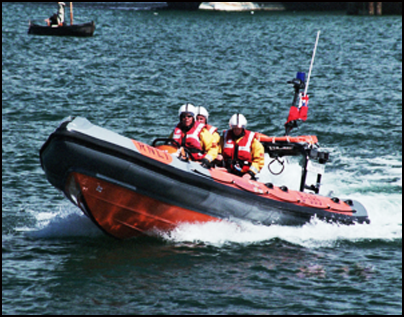-
What happened?
A fast rescue craft (FRC) was being used in a near-shore shallow water seismic survey.
The weather had been good, however, the conditions deteriorated, and the wind changed direction.
Equipment being towed became snagged on the seabed, acting as an anchor and turning the FRC into the wind.
The FRC capsized causing four people to fall into the sea.
Two people were not wearing lifejackets.
Fortunately, there were no injuries, but most of the work equipment was either damaged or lost.

-
Why did it happen?
When the weather deteriorated, the coxswain recommended running for shelter (stop the job) but was overruled by offshore vessel management.
The towed equipment became snagged on the seabed, turning the small boat stern towards the weather.
The boat was operating at its maximum load capacity. When it took on water over the stern, it capsized.
Incomplete risk assessment - the equipment snagging had not been recognised as a hazard.

-
What did they learn?
Never allow production pressures to take precedence over the safety of personnel.
Encourage personnel to stop the work and reassess the hazards if conditions change.
Ensure that procedures are in place for foreseeable emergency situations.
Ensure that small boats are suitable for the task and capable of working in all expected environmental conditions.
Never operate to the absolute limit of the vessel.

-
Ask yourself or your crew
Have you ever ‘stopped the job’ but been overruled? What happened?
Are you asked to operate any equipment at maximum load capacity? What dangers does this have?
Does the risk assessment for your task cover everything? What should you do if it doesn’t?
What are our emergency procedures for marine operations?

Add to homescreen
Content name
Select existing category:
Content name
New collection
Edit collection
What happened?
A fast rescue craft (FRC) was being used in a near-shore shallow water seismic survey.
The weather had been good, however, the conditions deteriorated, and the wind changed direction.
Equipment being towed became snagged on the seabed, acting as an anchor and turning the FRC into the wind.
The FRC capsized causing four people to fall into the sea.
Two people were not wearing lifejackets.
Fortunately, there were no injuries, but most of the work equipment was either damaged or lost.

Why did it happen?
When the weather deteriorated, the coxswain recommended running for shelter (stop the job) but was overruled by offshore vessel management.
The towed equipment became snagged on the seabed, turning the small boat stern towards the weather.
The boat was operating at its maximum load capacity. When it took on water over the stern, it capsized.
Incomplete risk assessment - the equipment snagging had not been recognised as a hazard.
What did they learn?
Never allow production pressures to take precedence over the safety of personnel.
Encourage personnel to stop the work and reassess the hazards if conditions change.
Ensure that procedures are in place for foreseeable emergency situations.
Ensure that small boats are suitable for the task and capable of working in all expected environmental conditions.
Never operate to the absolute limit of the vessel.
Ask yourself or your crew
Have you ever ‘stopped the job’ but been overruled? What happened?
Are you asked to operate any equipment at maximum load capacity? What dangers does this have?
Does the risk assessment for your task cover everything? What should you do if it doesn’t?
What are our emergency procedures for marine operations?
A fast rescue craft (FRC) was being used in a near-shore shallow water seismic survey. The weather conditions deteriorated, and the craft capsized.














